Winchester Model 1911 self-loading rifle (USA)
The development of new weapons, like previous projects, was led by designer Thomas Crossley Johnson. The development of a new self-loading rifle took a lot of time. During the design, the engineers at Winchester had to solve a number of complex design problems related both to the need to ensure that the mechanisms were working and to the requirements regarding intellectual property. T.K. Johnson and his colleagues were unlucky to face serious problems rooted in the field of patent law.
Recall that the Winchester Repeating Arms Company could start producing self-loading rifles at the end of the 19th century or at the very beginning of the 20th century. In 1898, designer John Moses Browning developed his first project of a self-loading rifle using automatic recoil-based barrel with a long stroke. The project was proposed to Winchester, but its management did not want to start the production of these weapons. Self-recharging guns were considered a hopeless invention. In addition, J.M. Browning demanded not only a fee for the acquisition of the project, but also a percentage of sales.
Having received a refusal from the leadership of the Winchester, the gunsmith began to search for a new manufacturer of his weapon. They eventually became the Belgian company Fabrique Nationale d'Herstal. Soon the Belgian company started the production of new guns, called Browning Auto-5. A large batch of such weapons was acquired by J.M. Browning and sent to the United States, where it was quickly sold out, showing the potential of such systems.
Seeing the consequences of their refusal, the management of the Winchester decided to catch up with unexpected competitors in the face of FN and create their own version of a self-loading rifle. However, this proved to be quite a challenge. Before proposing your project to manufacturing companies J.M. Browning received a number of patents on the main elements of the promising gun. Because of these patents, because Johnson and his colleagues could not use a rollback braking system based on profiled rings, an existing bolt design and even a reload knob placed on the bolt group.
Due to the existing restrictions, the Winchester designers had to not only create a new gun, but also look for new operating principles. As later joked TK Johnson, it took almost ten years to create a structure that would not violate the patents of J.M. Browning This task was successfully solved, which led to the emergence of several original ideas. Nevertheless, it took a long time to design a new gun, which ultimately had a negative impact on its promotion in the market.
In terms of overall layout, the Winchester Model 1911 shotgun should have a certain similarity to the Browning Auto-5 product. It was proposed to use a relatively long smooth barrel, under which was placed a tubular magazine. All the main parts were placed inside a metal receiver, to which was attached a wooden butt. However, due to patent issues, the similarity of the two samples was limited to only the most general features of their architecture.
In order to simplify the transportation of a sufficiently long weapon, TK Johnson and his colleagues once again used a collapsible design based on the ideas already developed. Like the previous self-loading rifles from Winchester, the M1911 rifle should have been divided into several basic units. It was possible to remove the lower frame of the receiver with a trigger and butt. Also provided for the separation of the receiver and the barrel with the barrel-mounted units. The resulting three components were fairly easy to transport and could easily assemble into combat-ready weapons.
One of the main parts of the weapon was a long, smooth barrel. In the basic version, the weapon was intended for use of caliber 12 cartridges (18,5 mm). In the future, several versions of the gun were created for other ammunition. The barrel was a long piece, on the bottom surface of which a tubular casing of the rollback braking system was attached. On the breech there was a block for interaction with the gate. In the central part of the trunk, on the outer surface, there was a grooved area for easy recharging.
Directly under the barrel was placed a tubular magazine for five rounds of 12 ammunition. Inside the store was a pusher with a twisted cylindrical spring. Outside, the body of the store was suggested to wear a return spring of the barrel. Also on the store were details of the barrel recoil braking. In the project J.M. Browns for this purpose were used washers with walls of complex conical shape. Moving on the washer, the barrel ring was supposed to compress it and increase the pressure on the surface of the magazine. Such interaction of parts led to a partial absorption of the recoil impulse and a decrease in the velocity of the barrel.
In view of the existence of a patent for an under construction, TK Johnson was forced to create his own version of the brakes. The M1911 rifle should have been equipped with fiber material washers placed between the surface of the magazine and the barrel tube. Such a system was simpler, but could not show high survivability. Subsequently, this feature of the design was one of the reasons for criticism.
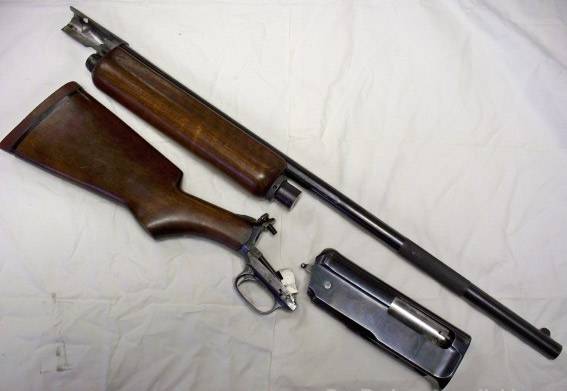
Dismantling weapons for transportation. Photo Guns.com
The barrel without any mounts installed in the front window of the receiver. Another round hole was under the window for the trunk and was intended for the store. Like the previous Winchester self-loading rifles, the promising rifle received a detachable receiver in the form of an upper part of a U-shaped cross section and a lower L-shaped frame. The upper part contained the shutter and some other details, and the lower one served as the basis for triggering.
Unlike previous self-loading rifles, TK Johnson, the Model 1911 rifle should not have been fitted with an extended bolt carrier. Instead, in the upper part of the receiver was placed shutter "classic" design, small length and cross section. Inside the gate was placed a spring-loaded drummer, and on its outer surface there was a swinging combat support for connection with the plate on the breech breech. It was proposed to control the movement of the stop and other parts by the interaction of special projections and grooves on the inner surface of the receiver. With its rear part, the shutter rested against its own return spring.
The design of the trigger type trigger was borrowed from existing projects. On the lower frame of the receiver were attached all the necessary parts, including the trigger, the mainspring, etc. The trigger was made in the form of a large swinging parts, interacting with the mainspring. The latter had a guide pin. In the cocked position, the trigger was blocked by the sear, connected with the trigger. There was also a fuse blocking the operation of the trigger.
In front of the bottom surface of the receiver was a window for equipment store. For equipment weapons should be consistently placed five rounds through this window in the store. When this occurred, the compression of the spring of the pusher. In the absence of effects, the window lid was automatically lowered and allowed the cartridges at the right moment of the recharge cycle to fall inside the receiver.
Winchester Model 1911 semi-automatic rifle received the most simple open mechanical sights. An unregulated fly was placed on the muzzle of the barrel, the sight was missing. By modern standards, this design of sighting devices looks like countries, but for its time it was normal and familiar.
It was proposed to equip a shotgun with traditional for that time wooden fittings in the form of separate forearm and butt. The forend covered the mechanisms located under the barrel, protecting them from negative external influences, and the shooter’s hands from possible injuries. To the bottom frame of the receiver was attached butt with a pistol protrusion. The rifle butts of some series were made of several pieces of wood glued together. Also produced "solid" products.
The inability to use proprietary ideas and solutions made the designers of the Winchester Repeating Arms Company use new ideas related to both the design of the weapon and the features of its use. In particular, the original innovations of the project led to an unusual method of recharging. To prepare the weapon for firing, 12 caliber cartridges should be placed in the magazine, and then its mechanisms should be cocked. Arming was proposed to carry out by moving the trunk back in the direction of the receiver. At the same time, the cock was cocked, the cartridge was seized and, when the barrel was moved forward, the ammunition was sent. After the fuse was turned off, the weapon was ready to fire.
When the trigger was pressed, the trigger was released, which, under the action of the mainspring, turned on its axis and hit the hammer placed inside the bolt. The recoil should have thrown back the barrel and the bolt engaged with it. The movement of the barrel to a certain extent was inhibited with the help of washers placed on the body of the store. When he reached his extreme position, the barrel stopped and then returned to the neutral position with its own return spring.
At the same time, the barrel was unlocked, after which the shutter continued to move backward, compressing its own return spring. At this stage, the liner was removed and then ejected through the side window of the receiver. Passing the back of his way, the shutter pressed the trigger down, bringing it to the position in which it was blocked by the sear. After this, the return spring was supposed to feed the valve forward. He captured and sent a new cartridge, then locked the barrel. Weapons could make a new shot.
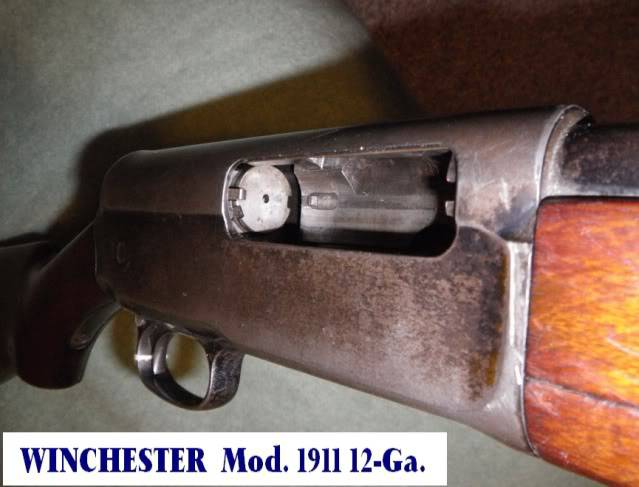
View of the bolt through the window for ejection. Photo Forums.gunboards.com
The need to search and refine new engineering solutions has led to a serious delay in the development process. Because of this, a new self-loading rifle went into series only in the 1911 year, having received the appropriate designation. The appearance on the market of a new self-loading rifle did not go unnoticed. The new model attracted the attention of amateur shooters and hunters. Guns Model 1911 were sold in significant quantities, the factory received all new orders for the supply of such products.
Wishing to conquer new market niches, for several years, Winchester has released a number of new modifications to the M1911 shotgun. They differed from the basic version in the barrel caliber and the parameters of the automation parts. 16, 20 and 28 caliber rifles were produced. Like the original version, such systems enjoyed a certain popularity.
Despite all the efforts of the developers, the new self-loading rifle retained some noticeable flaws. They affected the convenience of operation, and in some cases could even lead to accidents. First of all, a problem was identified with insufficient strength of the barrel braking system washers. In the project J.M. Browning used metal parts, whereas TK. Johnson had to use washers made of soft material. As a result, such washers tended to collapse after a certain number of shots, and in some cases even earlier.
The destruction of the pucks did not allow to reduce the speed of movement of the barrel, which seriously increased the recoil momentum. A powerful jerk when fired could have a negative impact on the strength and life of parts. In addition, damage to other parts was not excluded. So, there is evidence of damage to the butts: the recoil force led to cracking or even destruction of a wooden part. Naturally, there was a serious risk of injury to the shooter. To exclude such incidents, it was necessary to closely monitor the means of braking the barrel and replace worn washers in a timely manner.
Much more serious consequences could be associated with the use of low quality cartridges with a sleeve of cardboard or paper. Such a sleeve could pass moisture, which led to a partial removal of the cartridge from the cause of powder damage or disabling the capsule. In addition, the wet sleeve swelled and could no longer ensure the proper operation of the mechanisms. An attempt to remove the cartridge after a misfire was associated with significant risks. Some arrows tried to rest the rifle with the butt into the ground, and then with vigorous movement to press the barrel and make the mechanisms work properly. In this case, there was a great risk of abnormal ignition of the propellant charge, followed by a shot and the corresponding tragic consequences. The unfortunate shooter risked at least a serious injury or could have died. In order to avoid such incidents, recharging should be carried out by directing the barrel in a safe direction.
Attempts to reload the M1911 rifle with its butt-in to the ground and the upward direction of the barrel were a gross violation of safety precautions, so that blame for injuries or even death could not be laid solely on the rifle. However, the arrows argued differently, and the tragic incidents hit the reputation of the new product. For these features, the gun received the nickname Widowmaker ("Leaving widows"), which could not contribute to better sales.
However, despite all the problems, the Winchester Model 1911 self-loading rifle gained some popularity. Produced and transferred to customers of the party in the hundreds and thousands of new weapons. In total, about 83 thousand guns were manufactured in various calibers. All of these weapons were sold out over time and were used by the shooters with some kind of activity.
It should be noted that the self-loading rifle of the TK design. Johnson entered the market very late. By this time, FN with a gun J.M. managed to occupy a large market share. Browning, and in addition, there are new systems of a similar class, created by other firms. The appearance of the new model attracted attention, but the chances of obtaining a large market share were virtually absent. In addition, the existing design flaws made themselves felt.
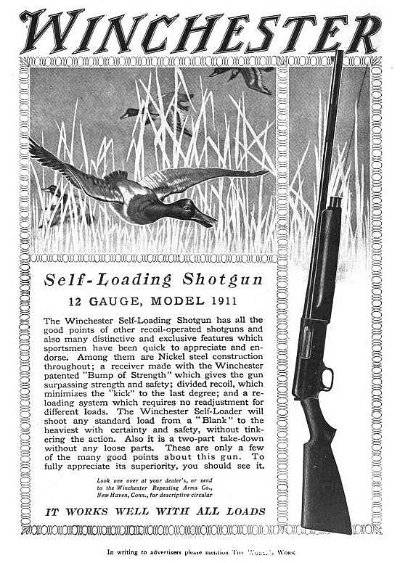
Advertising gun Model 1911. Figure Gunlore.awardspace.info
The Winchester Model 1911 shotgun had limited opportunities to compete with other weapons on the market, which led to various negative consequences, including a gradual decrease in sales. By the mid-twenties, the shooters' interest in this product was almost gone. The manufacturer was forced to remove the gun from mass production. The latest M1911 samples were released in the 1925 year.
Despite the long-standing cessation of production, the M1911 self-loading rifles are still available in the arsenals of hunters and other amateur shooters. At the same time, the relatively short duration of release and the corresponding number of products made did not allow the rifle to get the same distribution as the Browning Auto-5 system or the field of late analogues. Nevertheless, fired guns found their customers and can still be used for its intended purpose.
Unfortunately, the specific design and inappropriate safety attitude continue to lead to unexpected and tragic incidents. Destruction of the brake washers still increases the recoil momentum and can lead to injuries, and improper recharging, as before, threatens at least serious injuries. According to reports, the last random shot while trying to reload, which took the shooter’s life, happened not so long ago - in 2005.
The Winchester Model 1911 self-loading rifle, which became the first such product of Winchester, is of great interest for a number of reasons. At the same time, the bulk of these reasons are in one way or another connected with unusual prerequisites for the emergence of the project, as well as with the attempts of engineers to overcome the existing difficulties. By an oversight of the management of the company, a very successful project of J.M. Browning "left" to another weapon manufacturer, and the team of TK Johnson had to not only create his own gun again, but also to overcome the difficulties associated with the many patents on these or other systems.
Having spent about ten years, TK Johnson was able to create weapons that do not violate the patent rights of J.M. Browning, however, this goal was achieved at a fairly high price. In the design of weapons had to use compromise, ambiguous and even dubious solutions, which led to a lot of unpleasant consequences. As a result, a new weapon under the Winchester brand entered the market, but could not count on serious success. But it remains in stories as a curious sample of great interest.
On the materials of the sites:
http://guns.com/
http://gunlore.awardspace.info/
http://gunvaluesboard.com/
http://gundigest.com/
http://forums.gunboards.com/


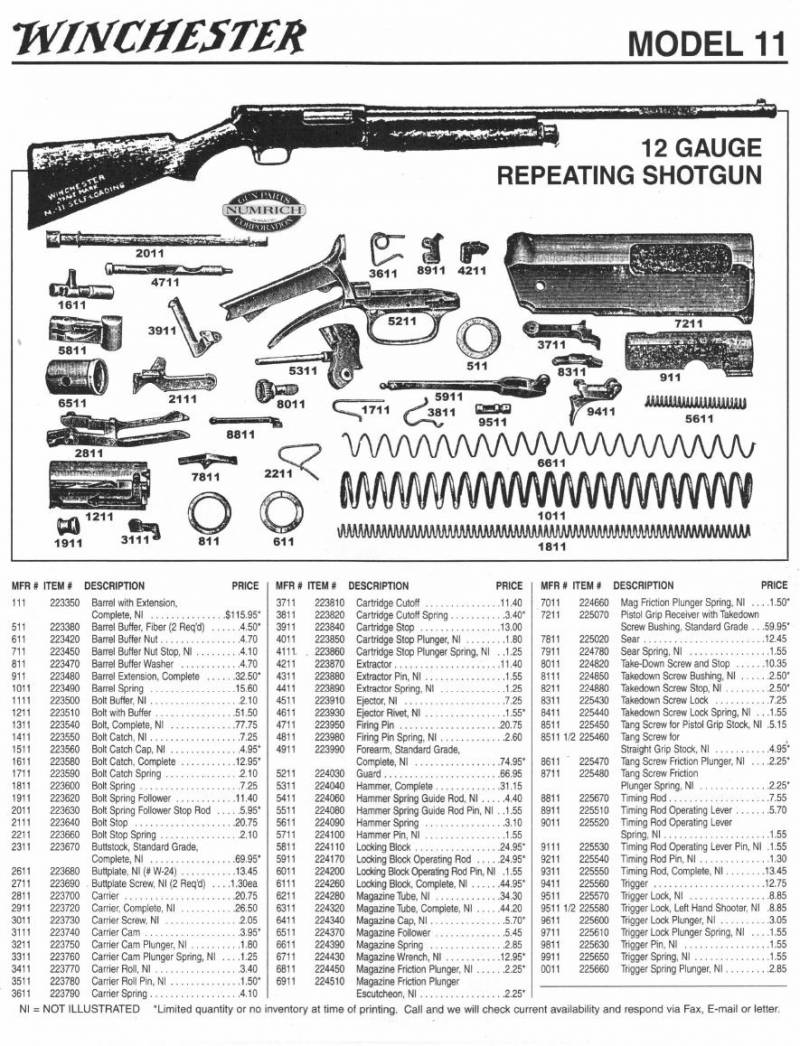
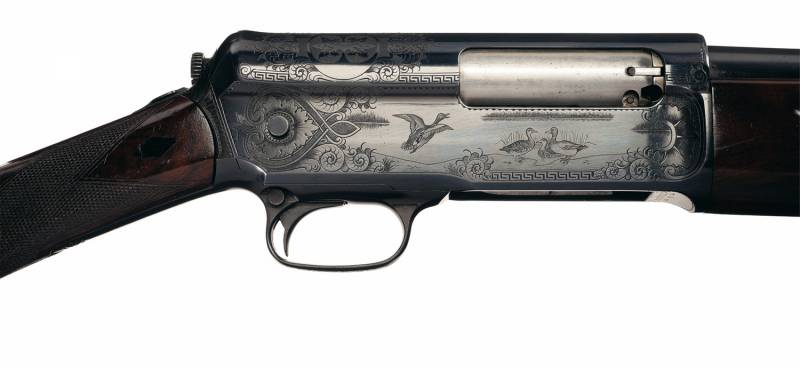
Information